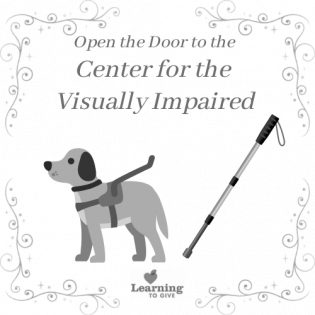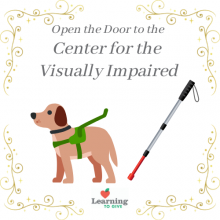Open the Door to the Center for the Blind and Visually Impaired
The "Open Doors to Your Community" project is a virtual door that guides young people to the actual door of local resources so they can learn about their community, take action, and build connections and understanding of their roles in the community.
What Is the Purpose of a Center for the Blind and Visually Impaired?
When someone's vision loss makes it difficult to navigate daily chores, the center provides training and support for basic life skills. People who are blind or visually impaired are just like sighted people. The best thing we can do is seek to understand how to communicate and be respectful of their abilities and interests. The center arranges gatherings of members so they can do activities together and learn from one another. They enjoy being with others with similar abilities, and they share ideas of what has helped them navigate their world with vision loss.
Meet a Patient Services Coordinator
In this brief video, we meet Elizabeth Nystrom. She tells us about the center and how others can get involved as community advocates or by raising money. Elizabeth became interested in working with the center when her grandmother benefited from the services and community. She used to drive her grandmother to her appointments at the center. This gave her insight into how the organization supports community members who are blind and visually impaired. Now as an employee, Elizabeth advocates for people who are visually impaired and educates the community about resources available for others.
Contact Your Local Center
Look up the contact information for the center that supports people who are blind or visually impaired in your community where you can learn about their services. Call to set up a phone or in-person interview. Tell them you'd like to learn more about the work of the center and best practices so you can get involved or volunteer to help their mission. Ask for 30 minutes or an hour of their time. The Interview Script linked here and below can help you make the call.
Interview Questions
These questions can help you learn about your community and ways you can get involved.
- What is the main purpose of a center that supports people who are blind or visually impaired? This may be its mission or vision.
- What are some challenges that people with visual impairment face? What are the different reasons people lose their vision (or are born with the impairment)?
- What are some things people who are blind can do to live and work independently?
- What can a young person do to participate in the community of people who are visually impaired?
Take Action in Your Community
Reflect on the needs of the center for visual impairment. What can you help them do? Your voice and time matter. The resources below can help you plan a project.
The best service-learning projects guide us to gain and use knowledge, are led by youth voice and passion, address a need, and develop connections with local resources over time.
 Learning to Give Issue Area Toolkits include background on the issue, community connections, lessons and activities, project ideas, and planning guides. Check out the Embracing Neuro and Physical Disability toolkit.
Learning to Give Issue Area Toolkits include background on the issue, community connections, lessons and activities, project ideas, and planning guides. Check out the Embracing Neuro and Physical Disability toolkit.
 Learning to Give Service Sparks guides provide directions for generous actions that encourage youth voice and promote the common good. Young people can interview a person with a visual impairment and tell their story to raise awareness of their abilities and strengths.
Learning to Give Service Sparks guides provide directions for generous actions that encourage youth voice and promote the common good. Young people can interview a person with a visual impairment and tell their story to raise awareness of their abilities and strengths.
 Learning to Give Literature guides combine selected literature with thought-provoking discussions and activities that teach about giving and civic engagement. Read aloud a picture book to a younger child or a retirement home buddy and talk about the community themes. The picture book Anna and Natalie is about a girl who is blind and her classmates and service dog. This story, with a surprising twist at the ending teaches the power of believing in your own talents and respecting the variety of ways people can be differently abled.
Learning to Give Literature guides combine selected literature with thought-provoking discussions and activities that teach about giving and civic engagement. Read aloud a picture book to a younger child or a retirement home buddy and talk about the community themes. The picture book Anna and Natalie is about a girl who is blind and her classmates and service dog. This story, with a surprising twist at the ending teaches the power of believing in your own talents and respecting the variety of ways people can be differently abled.
More about Visual Impairment and Blindness
Fun Facts:
- There are different degrees of blindness and visual impairment. Some people see shapes and colors. Each person's ability is different.
- Guide dogs follow the cues of the person who is listening to traffic and other clues.
- People who are blind are often very good at detecting aromas.
- Ray Charles and Stevie Wonder are two famous musicians who are also blind.
- Braille is the reading/writing system that uses arrangements of raised dots to represent letters.
- Echolocation is a system of using clicking noises and listening to the echoes to determine location. Bats use echolocation to navigate in flight. There are people who are blind, including Daniel Kish, who have learned this technique.
It doesn’t take special skills to be friends with a person who is blind. You’re interacting with a whole person, not their disability. Show them the respect they deserve and offer the following courtesies to people who are blind.
- Include people who are blind, and don't talk around them.
- Don't assume helplessness. Offer help directly to the person who is blind and be kind if they decline. Don't grab their arm or touch them without permission.
- Tell them when you arrive or leave rather than just appearing and disappearing.
- Communicate clearly. Give specific directions such as turn right or go straight. It is okay to use phrases such as "see you later" They are part of shared vocabulary.
- Don't shout to be understood. They can probably hear very well.

